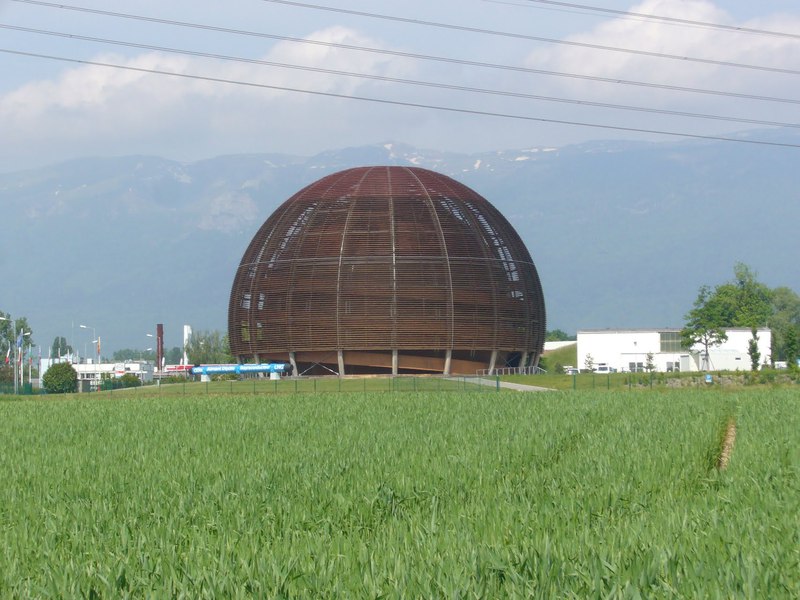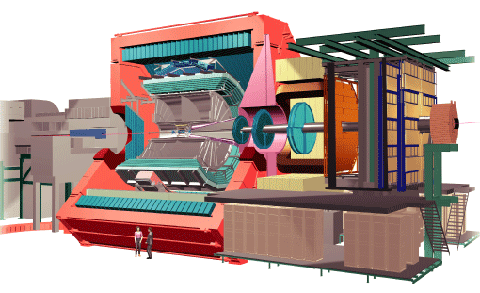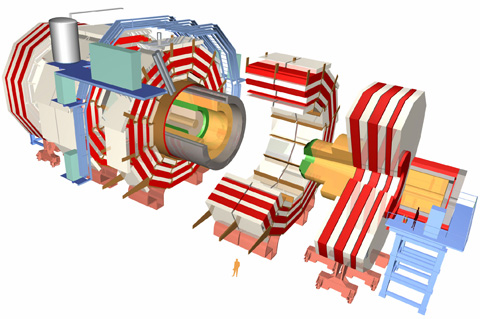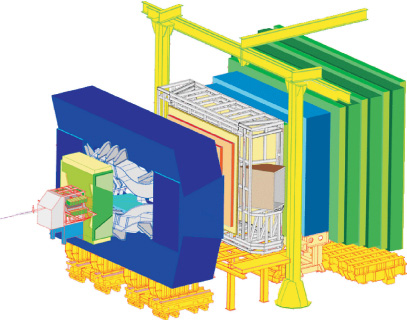CERN - what is an organization for $ 900 million
I was lucky to work this summer at CERN , in the cryogenics department. In this post I will tell, in general terms, what they are doing here.

Let's remember what CERN is.
CERN - Conseil Européen pour la Recherche Nucléaire (French), or the European Organization for Nuclear Research (English), an international center for nuclear research. He has been studying high-energy physics for the past 57 (September 29, will be 58) years. The best-known achievements for the unscientific world are “the creation of the Web” by Tim Lee (of course, before it, data transfer from server to client existed in some military organizations, but Tim Lee made the world's first server, accessible first only from CERN, and then from all over the world), development of the GRID system. Located on the border of Switzerland and France.
At the moment, CERN has the world's largest and most powerful accelerator LHC (Large Hadron Collider, LHC). There are 4 large experiments on this accelerator (there are more of them at CERN, but all of them either use the data obtained by these four or are not related to the accelerator at all): ALICE, ATLAS, CMS, LHCb. Let’s analyze in order what each of them does (for experts I’ll clarify that I’ll try to explain everything in such a way that it would be clear to people who are not connected with physics. Inaccuracies and errors can be discussed in the comments. But then, in fact, , each of these experiments deserves a separate article):
- ALICE :
As you all know, according to modern theory (and so far without reliable refutation), our universe came from the Big Bang 14 billion years ago. At one moment, all matter appeared, all energy, time and space, and then all this soup began to develop. We are now interested in this very soup of all that is possible immediately after the creation of the universe. The state in which the matter was at that time was plasma, with tremendous energy and temperature, and with very interesting properties. ALICE wants to reproduce the small Big Bang and observe the state of matter in the first seconds after the big explosion (This is the experiment that was supposed to create a black hole and kill us all, yes yes).

- ATLAS :
If you buy very expensive equipment, hire a hundred or two ingenious astrophysicists and spend several years studying space, you can see that the matter that we “see” makes up only about 5% of the mass of the entire Universe. The remaining 95% is the so-called dark matter (23%) and dark energy (72%). ATLAS is just trying to understand what kind of matter it is and why it is not visible (Theorists suggest that it is matter from other dimensions, but light spreads only in 3, and gravity - in all, that’s why we can notice the mass of this matter, but not to see it, but this is a very simple explanation that does not suit me - it seems that there are parallel worlds and other sci-fi nonsense, which is absolutely wrong). This experiment is also looking for the Higgs boson, which answers the question "why does the body have mass."

- CMS :
This experiment is looking for the same thing as ATLAS, only in other ways. However, as you may have read, it is he who is closer to finding the Higgs boson than ever.

- LHCb :
There is such a thing as antimatter. One of its properties is annihilation when interacting with matter (both of them turn into pure energy, nothing remains). In theoretical physics, almost everything is subject to symmetry, and this means that when creating matter and antimatter during the Big Bang, everything should annihilate and disappear. However, something went wrong as we suppose, and not all matter and antimatter annihilated (a divine bug, or a feature?). LHCb is trying to understand why this happened.

Here are actually the four largest physical experiments in the world. If anyone is interested, I can write about each of them separately.
Now let's see how it all works.
Each of the experiments accelerates particle beams in the accelerator to near-light speeds and collides them in its detector (one detector per experiment). ALICE collides lead ions (they have a large mass), ATLAS, CMS and LHCb proton. After the collision, the particles fly apart into smaller particles, which are observed by the detectors, and then the complete picture of the collision is restored from these data. The data from the detectors (here I mean exactly the single things that fix the particle, such as crystals, bubble chambers, etc. ...) are transmitted by an analog signal to the installations directly next to them, which, in turn, convert it into a digital signal and send it up to the processing and storage. The problem here is that there is a lot of this data. Lots of. An incredible amount. For instance,source ). And collisions occur within hours. Can you imagine the scale? To solve this problem, CERN developed the GRID system, which uses the power of many data centers in the world for its purposes. Again, if someone is interested in reading about detectors, I can write about them.

Move on. To disperse the particles, it is necessary to apply a strong magnetic field. Here, superconductors are used to supply current at temperatures from 1.7 to 4 Kelvin. Everything is cooled with helium: liquid helium is purchased, tons of commercials 500, and cooled to 4 according to Kelvin. And then, if necessary below, then to 1.7. There is nothing much to tell me here, since the description of the cooling system will be very long (If someone would be interested ... well, you understand). What I can add is that in 2008 there was an explosion in the tunnel, and it was because of the not perfect helium supply system that the whole accelerator stood up for half a year.
The story is this: we have two magnets, they are connected by wires, of course, the wires are soldered somewhere. The wires “float” in helium (I recall, at 1.7 Kelvin), and a current of about 20,000 amperes flows through them. The solder was made poorly, a small capacitor was obtained, which gave a spark, heated helium to 5 Kelvin. At 20,000 amperes and a temperature of 5 Kelvin, the wires began to heat up, heating helium around them ... The result - a magnet weighing 13 tons flew 30 meters, demolishing a couple of doors and walls, and bent; helium filled the entire section of the accelerator with gas. The problem was that people couldn’t even open the accelerator (during the accelerator’s operation inside the vacuum), because helium would interact with air, water would be produced (as a result of condensation from the air, water will be produced during rapid cooling, thanks frig), and would flood electronics into millions of dollars. I had to pump out, wait, and come up with new ways to solder these cables.
That's all. You can talk about CERN for as long as you want, but I think that for a general idea of what is here and how, this is enough. If you have questions, I will be glad.
PS: Links to articles on experiments:
- ATLAS experiment - a simplified description of the problem and a little about the detector

Let's remember what CERN is.
CERN - Conseil Européen pour la Recherche Nucléaire (French), or the European Organization for Nuclear Research (English), an international center for nuclear research. He has been studying high-energy physics for the past 57 (September 29, will be 58) years. The best-known achievements for the unscientific world are “the creation of the Web” by Tim Lee (of course, before it, data transfer from server to client existed in some military organizations, but Tim Lee made the world's first server, accessible first only from CERN, and then from all over the world), development of the GRID system. Located on the border of Switzerland and France.
At the moment, CERN has the world's largest and most powerful accelerator LHC (Large Hadron Collider, LHC). There are 4 large experiments on this accelerator (there are more of them at CERN, but all of them either use the data obtained by these four or are not related to the accelerator at all): ALICE, ATLAS, CMS, LHCb. Let’s analyze in order what each of them does (for experts I’ll clarify that I’ll try to explain everything in such a way that it would be clear to people who are not connected with physics. Inaccuracies and errors can be discussed in the comments. But then, in fact, , each of these experiments deserves a separate article):
- ALICE :
As you all know, according to modern theory (and so far without reliable refutation), our universe came from the Big Bang 14 billion years ago. At one moment, all matter appeared, all energy, time and space, and then all this soup began to develop. We are now interested in this very soup of all that is possible immediately after the creation of the universe. The state in which the matter was at that time was plasma, with tremendous energy and temperature, and with very interesting properties. ALICE wants to reproduce the small Big Bang and observe the state of matter in the first seconds after the big explosion (This is the experiment that was supposed to create a black hole and kill us all, yes yes).

- ATLAS :
If you buy very expensive equipment, hire a hundred or two ingenious astrophysicists and spend several years studying space, you can see that the matter that we “see” makes up only about 5% of the mass of the entire Universe. The remaining 95% is the so-called dark matter (23%) and dark energy (72%). ATLAS is just trying to understand what kind of matter it is and why it is not visible (Theorists suggest that it is matter from other dimensions, but light spreads only in 3, and gravity - in all, that’s why we can notice the mass of this matter, but not to see it, but this is a very simple explanation that does not suit me - it seems that there are parallel worlds and other sci-fi nonsense, which is absolutely wrong). This experiment is also looking for the Higgs boson, which answers the question "why does the body have mass."

- CMS :
This experiment is looking for the same thing as ATLAS, only in other ways. However, as you may have read, it is he who is closer to finding the Higgs boson than ever.

- LHCb :
There is such a thing as antimatter. One of its properties is annihilation when interacting with matter (both of them turn into pure energy, nothing remains). In theoretical physics, almost everything is subject to symmetry, and this means that when creating matter and antimatter during the Big Bang, everything should annihilate and disappear. However, something went wrong as we suppose, and not all matter and antimatter annihilated (a divine bug, or a feature?). LHCb is trying to understand why this happened.

Here are actually the four largest physical experiments in the world. If anyone is interested, I can write about each of them separately.
Now let's see how it all works.
Each of the experiments accelerates particle beams in the accelerator to near-light speeds and collides them in its detector (one detector per experiment). ALICE collides lead ions (they have a large mass), ATLAS, CMS and LHCb proton. After the collision, the particles fly apart into smaller particles, which are observed by the detectors, and then the complete picture of the collision is restored from these data. The data from the detectors (here I mean exactly the single things that fix the particle, such as crystals, bubble chambers, etc. ...) are transmitted by an analog signal to the installations directly next to them, which, in turn, convert it into a digital signal and send it up to the processing and storage. The problem here is that there is a lot of this data. Lots of. An incredible amount. For instance,source ). And collisions occur within hours. Can you imagine the scale? To solve this problem, CERN developed the GRID system, which uses the power of many data centers in the world for its purposes. Again, if someone is interested in reading about detectors, I can write about them.

Move on. To disperse the particles, it is necessary to apply a strong magnetic field. Here, superconductors are used to supply current at temperatures from 1.7 to 4 Kelvin. Everything is cooled with helium: liquid helium is purchased, tons of commercials 500, and cooled to 4 according to Kelvin. And then, if necessary below, then to 1.7. There is nothing much to tell me here, since the description of the cooling system will be very long (If someone would be interested ... well, you understand). What I can add is that in 2008 there was an explosion in the tunnel, and it was because of the not perfect helium supply system that the whole accelerator stood up for half a year.
The story is this: we have two magnets, they are connected by wires, of course, the wires are soldered somewhere. The wires “float” in helium (I recall, at 1.7 Kelvin), and a current of about 20,000 amperes flows through them. The solder was made poorly, a small capacitor was obtained, which gave a spark, heated helium to 5 Kelvin. At 20,000 amperes and a temperature of 5 Kelvin, the wires began to heat up, heating helium around them ... The result - a magnet weighing 13 tons flew 30 meters, demolishing a couple of doors and walls, and bent; helium filled the entire section of the accelerator with gas. The problem was that people couldn’t even open the accelerator (during the accelerator’s operation inside the vacuum), because helium would interact with air, water would be produced (as a result of condensation from the air, water will be produced during rapid cooling, thanks frig), and would flood electronics into millions of dollars. I had to pump out, wait, and come up with new ways to solder these cables.
That's all. You can talk about CERN for as long as you want, but I think that for a general idea of what is here and how, this is enough. If you have questions, I will be glad.
PS: Links to articles on experiments:
- ATLAS experiment - a simplified description of the problem and a little about the detector
